STANLEY KUBRICK'S KILLER'S KISS
A SHOT-BY-SHOT ANALYSIS
PART FOUR

Go to TOC for this film ( (which has also a statement on purpose and manner of analysis and a disclaimer as to caveat emptor and my knowing anything authoritatively, which I do not, but I do try to not know earnestly, with some discretion, and considerable thought).
TOC and Supplemental Posts | Part 1 | Part 2 | Part 3 | Part 4 | Films Home
LINKS TO SECTIONS OF THE ANALYSIS ON THIS PAGE:
The Fight for His Life, Shots 326 through 494
Locations. Dumbo District and Plymouth and Adams.
The Ace of Spades and the Four of Spades
Himberama, Orson Welles and the Card Trick Distraction. The actor who played Davie was in Orson Welles' theater company in Paris.
Davey's Dream and his Crash Through the Window. The influence of Cocteaus Orpheus.
The Broken Window at the 24th Street Loft, 240, and the Clowns
Back to the "Blue Jeans" Poster
The Mannequin Factory
Iris, the Labrys, the Fleur-de-lys, and the Killing of Vincent
On Kubrick's Showing in Killer's Kiss the Rationale of Paying Attention to Shot Numbers. The sleeping cars of the train the same numbers of the last shots of the film.
The Selling of the Movie
Why Kubrick Might Have Been Interested in the Girl Hunt Ballet
326 Seagulls in early morning light. (48:32)
327 An empty street much like the streets in Davey's dream. (48:42)
Two cars travel toward the camera.
328 CU of stoplight. (48:51)
329 Vincent's car and the cab stop at the light. (48:55)
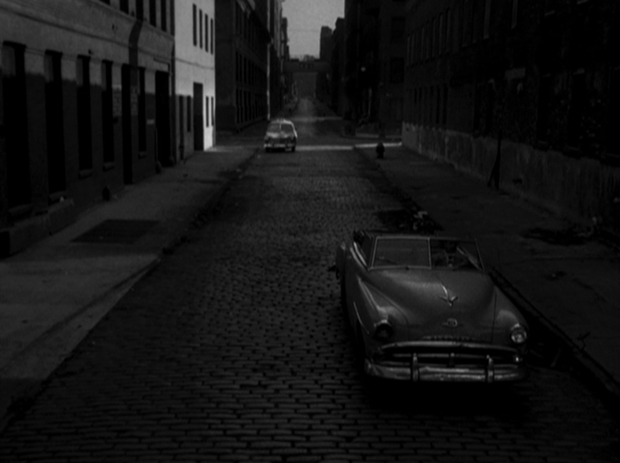
330 MCU Vincent in his car. (49:02)
The sound of a door of the cab opening and closing. Vincent is surprised by Davey climbing in the car with him.
DAVEY: Good morning, Mr. Rapallo. Sorry I missed you..
331 CU of stoplight. (49:09)
DAVEY: ...at the arena last week, but uh...
332 MS of cab leaving. (49:11)
DAVEY: ...Mr. Roberts told me to tell you...
333 MCU from rear of Vincent with Davey pointing a gun at his chest. (49:15)
DAVEY: That was my manager you knocked off.
VINCENT: I don't know what you're talking about.
DAVEY: Where is she?
VINCENT: What do you mean?
DAVEY: The girl! Where is she?
VINCENT: I don't know.
DAVEY: You don't know. (Raising the gun to his chin.) I'm going to count to three...
334 MCU from front of Vincent with Davey pointing a gun at his chin. (49:27)
DAVEY: ...and if you still don't know I'm going to blow your brains out. One...two...
VINCENT: She's in a loft on 24th street.
DAVEY: How'd she get there?
VINCENT: Boys were waiting at her apartment.
DAVEY: Is she all right?
VINCENT: Yeah, sure, she's all right. I had to do it. She saw the boys at the dance hall. She was a witness. I thought you were dead.
335 LS of the street and the car. (49:47)
VINCENT: They grabbed her, made it look like she'd packed up and left. I thought you were dead.
336 MCU from front of Vincent with Davey pointing a gun at his chin. (49:51)
VINCENT: I didn't want murder. It's all gone wrong.
DAVEY: Get going.
337 The car drives off. (49:59)
Crossfade to the car turning left onto another street.
338 LS The car turns left onto another empty street. (50:09)
The car parks. Vincent and Davey climb out and Vincent opens a door.
Shot 326 | Shot 327 |
 |  |
Shot 328 | Shot 329 |
 |  |
Shot 330 | Shot 331 |
 |  |
Shot 332 | Shot 333 |
 |  |
Shot 334 | Shot 335 |
 |  |
Shot 336 | Shot 337 |
 |  |
338 LS The car turns left onto another empty street. (50:09)
It parks. Vincent and Davey climb out and Vincent opens a door.
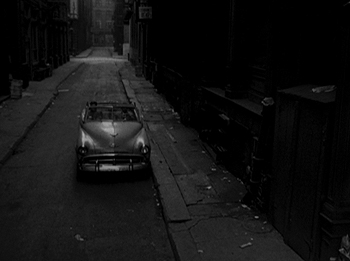
339 MS Door opening from within. (50:27)
Vincent and Davey enter.
340 Davey and Vincent enter an elevator and ride up. (50:34)
341 Gloria tied up in the room and the two gangsters playing cards. (50:34)
GANGSTER: Is that you, Mr. Rapallo?
VINCENT (off screen): Yeah, it's me, boys.
342 The elevator coming up the elevator shaft. (50:54)
343 Vincent and Davey enter the loft (51:15)
Davey pushes Vincent out of the way and orders the gangsters up.
344 MLS The gangsters rise from the table. (51:19)
345 MCU Gloria. (51:21)
346 MLS Davey. (51:23)
DAVEY: Against the wall. Lean on your hands.
347 MLS The gangsters rise from the table. (51:25)
348 MCU One of the gangsters with the Ace of Spades. (51:27)
349 MLS The gangsters and Rapallo leaning against the wall. (51:30)
350 MCU Gloria. (51:36)
351 LS Davey collecting the gangsters' guns. (51:38)
352 A gun falls on the ground next a piece of string and cigarette butt. (51:47)
353 LS Davey shoves the gun aside with his foot. (51:48)
Shot 338 | Shot 339 |
 |  |
Shot 340 | Shot 341 |
 |  |
Shot 342 | Shot 343 |
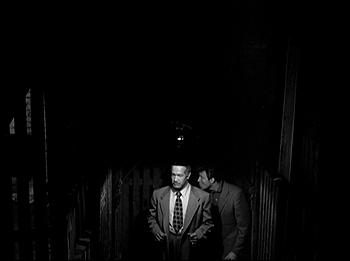 |  |
Shot 344 | Shot 345 |
 |  |
Shot 346 | Shot 347 |
 |  |
Shot 348 | Shot 349 |
 |  |
Shot 350 | Shot 351 |
 |  |
Shot 352 | Shot 353 |
 |  |
354 MCU Vincent. (51:52)
355 LS Davey picks up the gun. (51:54)
356 Gloria and Davey. (51:57)
He attempts to untie her.
DAVEY: How are you, baby?
357 MLS The gangsters against the wall. (52:02)
GLORIA (off screen): I'm okay.
DAVEY: I can't get the rope.
358 Gloria and Davey. (52:08)
GLORIA: Be careful.
359 MCU One of the gangsters. (52:10)
360 Gloria and Davey. (52:12)
DAVEY (pointing to the gangster): You.
361 MCU One of the gangsters. (52:14)
DAVEY (off screen): Yeah, you.
364 Gloria and Davey. (52:16)
DAVEY (pointing to the gangster): Untie her.
363 MCU One of the gangsters. (52:20)
364 Gloria and Davey. (52:22)
Davey stands aside.
365 The gangster goes over to Gloria. (52:24)
366 MS The gangster untying Gloria. (52:30)
367 MLS Rapallo and the other gangster. (52:33)
A train or boat whistle.
368 CU Gangster holding the Ace of Spaces and 4 of Spades. (52:35)
A train or boat whistle.
369 CU The gangster with the Ace of Spades. (52:36)
370 MS Davey. (52:37)
371 MLS Rapallo and the gangster. (52:39)
372 MS Gangster untying Gloria. (52:41)
He glances at the cards.
373 CU Gangster holding the Ace of Spaces and 4 of Spades. (52:43)

374 CU The gangster with the Ace of Spades. (52:43)
He winks at the other gangster.
375 MS Gangster untying Gloria. (52:44)
376 MS Davey. (52:47)
377 MS The gangster untying Gloria. (52:47)
He grabs her head, pulls her head back and bites her neck, her scream distracting Davey.
378 MS The gangster with the Ace of Spades. (52:50)
He looks back at Davey, no longer holding the Ace of Spades but the 5 of Diamonds showing. He flings the cards at Davey and lunges at him.
379 MS The cards flung at Davey's head. (52:51)
380 MLS The other gangster lunges at Davey, knocking the gun out of his hand. (52:52)
381 MS The two gangsters grapple with Davey. One hits him on his glass chin. (52:54)
382 MCU Davey is struck again and we see Vincent has moved behind Gloria. (52:55)
Davey is struck again in the face and then gets a knee to the face. He collapses.
383 MS of Gloria. (53:00)
384 CU Gun on the floor. (53:02)
Vincent retrieves it.
385 LS The scene, the guns taken from Davey's pockets. (53:04)
386 MCU Gloria stands over Davey. (53:10)
She then grabs Vincent and pulls him against her, attempting to seduce him.
GLORIA: Listen, Vinnie, don't kill me. I don't want to die. I'll do anything you say. Anything.
387 Vincent from beyond Gloria's right shoulder. (53:26)
VINCENT: You love him, though, don't you?
GLORIA: I don't know. I don't think so. I've only known him two days.
VINCENT: Two days.
GLORIA: Please, Vinnie. Please don't kill me. You said you were mad about me, remember?
VINCENT: I'm just an old man and I smell bad. Remember?
388 MCU Gloria from beyond Vincent's right shoulder. (53:45)
GLORIA: I didn't mean it. You know I didn't mean it.
She kisses him.
389 MCU Gloria and Vincent. (53:55)
Vincent smiles, which reassures her, and he kisses her again.
VINCENT: We could go away.
GLORIA: Sure.
VINCENT: Sure, I've got lots of money. We could have loads of fun some place, sure. London, Paris, Sicily.
GLORIA: I'll do anything you want.
VINCENT: Maybe we could get married. Settle down. Have a couple of kids.
GLORIA: Sure.
VINCENT: What do you take me for? 14 karat sucker?
390 MCU Davey on the floor beside Jack of Spades. (54:33)
VINCENT (off screen): You and lover boy aren't going to put me in the hot seat.
GLORIA (off screen): You liked me once, remember? Remember how nice it was? It could be like that again, Vinnie. It could be like that again.
VINCENT (off screen): You forgetting about him?
391 MLS Davey on the floor, the window beyond. (54:43)
GLORIA: I don't care about him.
VINCENT (off screen): Look, baby, you could have had anything once, but, no, you were too good for me. So you come up to my...
392 MS The window. (54:48)
VINCENT: ...office to get me mad. So I send my boys down to work over loverboy.
393 MCU Davey on the floor. (54:51)
VINCENT: So they grab the wrong...
394 MLS A gangster. (54:52)
VINCENT: ...guy. So he bangs his head too hard...
395 MCU Davey's feet next the gangster's, the 5 of spades beyond. (54:54)
VINCENT: ...on the sidewalk. So that makes me the sucker, huh?
396 CU Gangster. (54:56)
VINCENT: Not on your life, baby. Not on your life!
397 MCU Davey's foot unbalancing the gangster. (54:59)
VINCENT: Not on your life, baby. Not on your life!
398 MS Davey stands and rushes for the window. (55:01)
399 MS Davey plunges through the window. (55:03)

Shot 382 | Shot 383 |
 |  |
Shot 384 | Shot 385 |
 |  |
Shot 386 | Shot 387 |
 |  |
Shot 388 | Shot 389 |
 |  |
Shot 390 | Shot 391 |
 |  |
Shot 392 | Shot 393 |
 |  |
Shot 394 | Shot 395 |
 |  |
Shot 396 | Shot 397 |
 |  |
Shot 398 | Shot 399 |
 |  |
400 MLS Davey landing on the street below. (55:06)
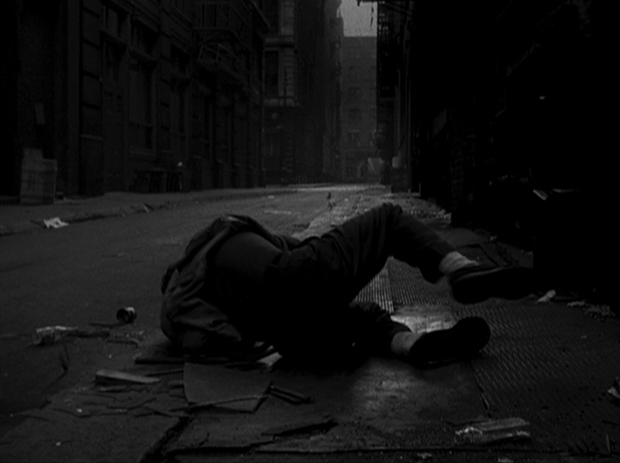
401 LS Vincent and the gangsters looking out the window. (55:10)
VINCENT: Don't shoot! Come on!
402 LS Vincent and the gangsters run past Gloria for the elevator. (55:12)
VINCENT (remembering Gloria): You stay with her! Go on!
One of the gangsters climbs out of the elevator as it's going down.
403 CU Gloria. (55:21)
404 LS Davey outside, still struggling to stand. (55:24)
We hear a train whistle. Holding his jaw, he rises and runs.
405 Davey runs down the street. (55:34)
406 MLS The gangster who stayed with Gloria goes to the window. (55:40)
407 Davey running down the street. (55:43)
He cuts right at the end of the street.
408 Vincent and the gangster emerge on the street. (55:51)
VINCENT: He went down there!
409 The street, Vincent and the gangster running down it. (55:53)
VINCENT: Be careful. It's a dead end alley. He'll never get out.
410 LS Davey running into the alley. (56:01)
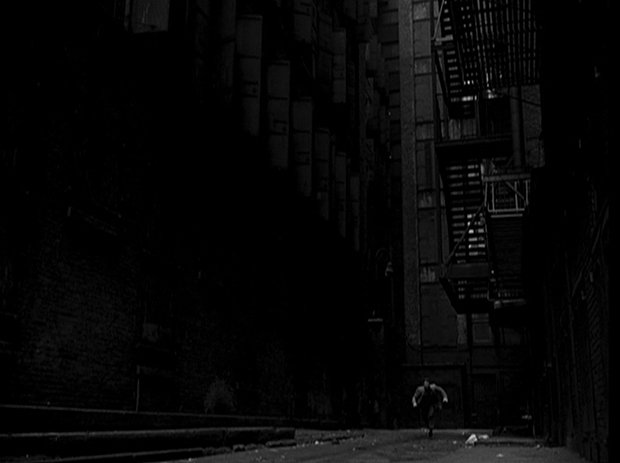
411 LS Davey runs through another portion of the alley. (56:08)

412 Davey reaches the dead end. (56:18)
413 Davey runs up a fire escape. (56:22)
414 LS Davey pulls up the stairs behind him. (56:32)
415 LS Vincent and the gangster run down the dark alley. (56:39)
Sound of train whistle.
416 LS Davey at the top of the fire escape. (56:53)
He throws a board at them.
GANGSTER: Look out!
417 Vincent and the gangster in the alley, viewd from above. (57:00)
VINCENT: Get that down! Come on! Hurry
The gangster climbs up and lets down the stairs.
418 Vincent and the gangster climb the escape. (57:13)
419 Davey runs across the roof. (57:21)
He runs all the way down to the end, trying doors. He crosses. He runs back.

420 LS Vincent and the gangster reach the roof. (58:15)
421 Davey running across the roof from above. (58:20)
422 Vincent and the gangster race across the roof. (58:25)
The gangaster falls. Continues on.
423 Davey clambers over a wall on the roof. (58:36)
424 LS From above of Vincent and the gangster running across the roof. (58:42)
425 MS Davey running. (58:47)
426 LS Vincent and the gangster climb the wall. (58:49)
The gangster is down. He injures his ankle and can't go on.
427 Davey goes down another fire escape (59:11)
Davey is able to enter the second floor down as Vincent reaches the escape.
Shot 400 | Shot 401 |
 |  |
Shot 402 | Shot 403 |
 |  |
Shot 404 | Shot 405 |
 |  |
Shot 406 | Shot 407 |
 |  |
Shot 408 | Shot 409 |
 |  |
Shot 410 | Shot 411 |
 |  |
Shot 412 | Shot 413 |
 |  |
Shot 414 | Shot 415 |
 |  |
Shot 416 | Shot 417 |
 |  |
Shot 418 | Shot 419 |
 |  |
Shot 420 | Shot 421 |
 |  |
Shot 422 | Shot 423 |
 |  |
Shot 425 | Shot 425 |
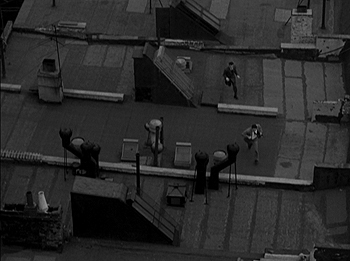 |  |
Shot 426 | Shot 427 |
 |  |
428 The mannequin factory. (59:17)
Davey enters the mannequin factory. We see a man in a neighboring room working on a mannequin. Vincent also enters. The man puts down the mannequin to look and see what's going on.
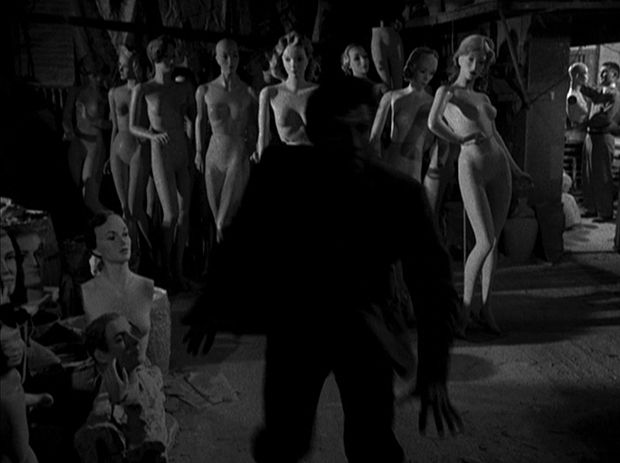
429 MLS Vincent in the mannequin factory. (59:37)
430 MLS The worker. (59:41)
431 MS Vincent. (59:43)
432 MCU Vincent attacks the worker. (59:46)
433 MCU Vincent wrestling the worker for the gun. (59:47)
434 LS Vincent and the worker wrestling. (59:51)
435 MS of the gun dropped. (59:52)
436 MS The fight. Vincent knocks the worker out. (59:54)
437 LS Vincent. (59:55)
VINCENT: My god. I've got to get out of here.
438 Davey in profile. (1:00:02)
He advances and tries a side door, but it's locked. He hides.

439 LS Vincent. (1:00:48)
440 MCU Davey. (1:00:56)
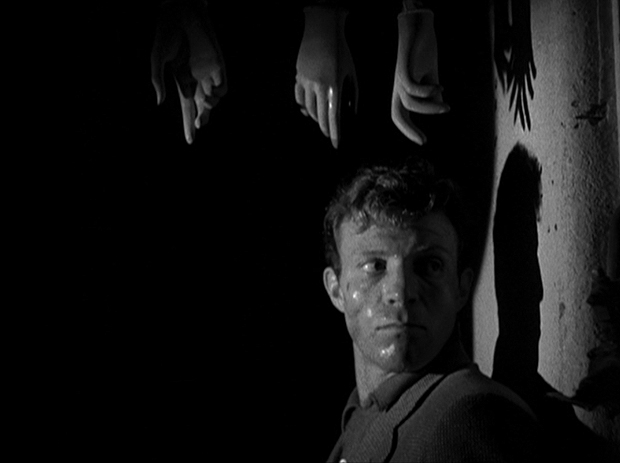
441 Vincent. (1:01:05)
He, too, now goes and tries the locked door.
442 MLS Davey. (1:01:20)
Davey steps out of hiding.
443 CU Vincent. (1:01:29)
444 MCU Vincent. (1:01:35)
He grabs a mannequin bust.
445 MLS Vincent with the bust. (1:01:37)
446 MS Davey approaches. (1:01:38)
447 MLS Vincent with the bust. (1:01:39)
He notices the axe on the wall.
448 MS Davey continues to approach. (1:01:42)
449 MS Vincent with the bust. (1:01:44)
He throws the bust at Davey.
450 MS Davey is knocked on the face and falls back and down. (1:01:44)
451 MS Vincent grabs the axe. (1:01:46)
452 MS Davey leaps up. (1:01:48)
453 MCU Vincent with the axe. (1:01:50)
454 MS Davey. (1:01:51)
455 MCU Vincent with the axe. (1:01:52)
456 LS Davey. (1:01:57)
Davey pushes a mannequin at Vincent, who hits it away with the axe. Again, he throws another mannequin at Vincent who dismembers it with the axe. Davey takes up a mannequin leg as a weapon.
457 MS Vincent. (1:02:09)
Unexpectedly, dust is thrown in Vincent's face.
458 LS Davey picks up a mannequin and throws it at Vincent. (1:02:11)
459 MS Vincent again hit with dust. (1:02:12)
More dust bombards Vincent.
460 LS Davey assails with more mannequin parts. (1:02:13)
461 MS Vincent steps back. (1:02:14)
462 LS Davey throwing mannequin head. (1:02:14)
463 MS Vincent is struck with the head. (1:02:16)
464 Davey picks up mannequin legs to throw but stops as police sirens are heard. (1:02:19)
465 MS Vincent. (1:02:19)
466 LS Police car from above. (1:02:21)
They get out.
OFFICER: I don't see anything. Do you, Joe?
RADIO: Car 14, car 14.
OFFICER: Well, let's go up to the roof anyway and take a look.
467 MS Vincent. (1:02:41)
Vincent retreats and tries to open the door with the axe.
468 MS Davey. (1:02:47)
469 MCU Vincent. (1:02:56)
470 MLS Davey and Vincent. (1:02:58)
Davey throws the mannequin then grabs a spear as Vincent tries to extract the axe from the door. Davey strikes the door with the spear, which opens, and Vincent steps back with the axe. He strikes at Davey.
471 MS Davey and Vincent. (1:03:03)
They spar with their weapons.
472 MS Davey and Vincent. (1:03:08)
Davey spears a mannequin and deflects Vincent's axe. He forces him back beyond a pillar.
473 MS Swinging mannequin hands. (1:03:17)
474 LS Vincent and Davey. (1:03:19)
They deflect each other's weapons until Davey gets his spear stuck in a mannequin and Vincent falls down.
475 LS Vincent picks up a mannequin leg. (1:03:39)
He throws it at Davey.
476 CU The spear. (1:03:44)
477 LS Vincent and Davey. (1:03:45)
478 The swinging mannequin hands. (1:03:51)
479 LS Vincent and Davey. (1:03:53)
Vincent down, Davey spears another mannequin. Vincent gets back up and misses with his axe. Again, Vincent is thrown down, again Davey spears a mannequin as Vincent rolls away. This time, the mannequin is stuck on the end of the spear as Vincent and Davey continue to fight.
480 MLS Vincent. (1:04:17)
Vincent swings a couple of times.
481 MLS Vincent. (1:04:21)
482 MS Vincent and Davey. (1:04:22)
483 MS Vincent and Davey. (1:04:24)
484 LS Vincent and Davey. (1:04:29)
This time, Davey successfully gets Vincent down and spears him. Vincent screams.
485 CU Mannequin face. (1:04:32)
Begin blur transition to shot 486.
Shot 428 | Shot 429 |
 |  |
Shot 430 | Shot 431 |
 |  |
Shot 432 | Shot 433 |
 |  |
Shot 434 | Shot 435 |
 | 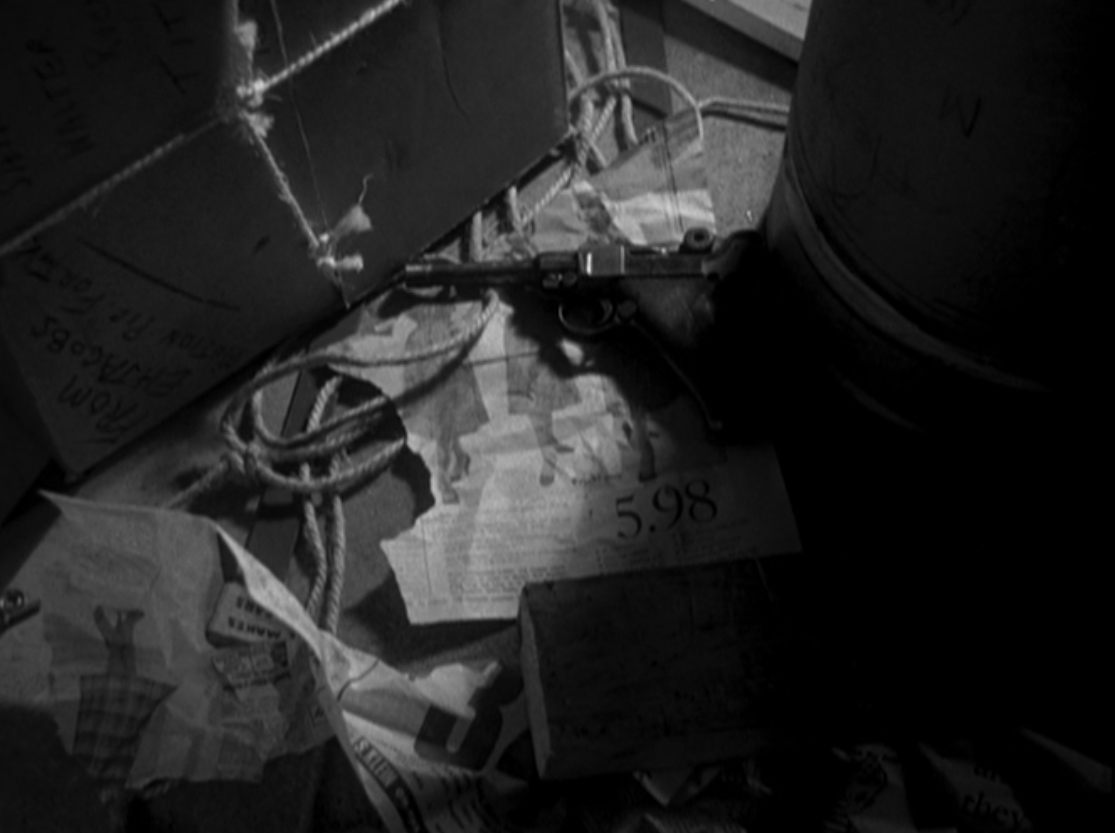 |
Shot 436 | Shot 437 |
 |  |
Shot 438 | Shot 439 |
 |  |
Shot 440 | Shot 441 |
 |  |
Shot 442 | Shot 443 |
 |  |
Shot 444 | Shot 445 |
 |  |
Shot 446 | Shot 447 |
 |  |
Shot 448 | Shot 449 |
 |  |
Shot 450 | Shot 451 |
 |  |
Shot 452 | Shot 453 |
 |  |
Shot 454 | Shot 455 |
 |  |
Shot 456 | Shot 457 |
 |  |
Shot 458 | Shot 459 |
 |  |
Shot 460 | Shot 461 |
 |  |
Shot 462 | Shot 463 |
 |  |
Shot 464 | Shot 465 |
 |  |
Shot 466 | Shot 467 |
 |  |
Shot 468 | Shot 469 |
 |  |
Shot 470 | Shot 471 |
 |  |
Shot 472 | Shot 473 |
 |  |
Shot 474 | Shot 475 |
 |  |
Shot 476 | Shot 477 |
 |  |
Shot 478 | Shot 479 |
 |  |
Shot 480 | Shot 481 |
 |  |
Shot 482 | Shot 483 |
 |  |
Shot 484 | Shot 485 |
 |  |
486 Davey at Penn station. (1:04:34)
Vincent's scream turns into a train whistle.
487 MS Davey. (1:04:40)
DAVEY (narration): After the cops came, I took them back to free Gloria. The guy on the roof was picked up later. On the ride to the police station, Gloria didn't say very much. I guess she was trying to work out in her own mind why I ran and left her alone like that. I don't suppose she ever thought about how I might have felt listening to her talk to Rapallo that way. At the station house they separated us for questioning. Five hours later they chalked off Rapallo as self defense and then worked a confession from the hoods on Albert's murder. I was free. On my way out, the desk sergeant said that Gloria had left an hour before. There was no message for me and I haven't heard from her or seen her since. And, now, I don't suppose I ever will again. Well, anyway, I guess the whole thing was pretty silly. Know a girl for two days and fall in love. So, I cashed my check, sent flowers to Albert's widow, cleaned up, and here I am.
488 LS Davey. (1:05:32)
STATION ANNOUNCER (voice-over): The Pathfinder to Chicago and Seattle leaving at 2 o'clock, West Gate, Track 13. Passengers for Pittsburgh, Chicago, St. Louis and Seattle, this train has reserved...dining cars, and sleeping cars designated as 494...
489 MS Davey (picking up his bag and walking for the train). (1:06:03)
STATION ANNOUNCER (voice-over): 493, 492. 491 and 490. The Pathfinder for Chicago and Seattle, leaving...
490 LS Taxi pulling up and Gloria climbing out. She runs to the station. (1:06:17)
491 LS Gloria runs down the 8th Avenue staircase. (1:07:13)
492 LS Davey walking through the station. (1:07:13)
GLORIA (off screen): Davey! Davey!
493 MLS Gloria running for Davey. She catches and kisses him. (1:07:13)
494 LS Gloria and Davey hug. (1:07:13)
Shot 485a | Shot 486 |
 |  |
Shot 486a | Shot 487 |
 |  |
Shot 488 | Shot 489 |
 |  |
Shot 490 | Shot 491 |
 |  |
Shot 492 | Shot 493 |
 |  |
Shot 494 | |
 | |
The location of shot 337 is Plymouth and Adams in the Dumbo district. I searched and searched and searched and finally found it, and then it turns out it's on a NYC film location site, but they don't have Google screenshots. The single story building on the right is still there. Is blue in the two below screenshots.

As best as I can tell, the warehouses upon which the running around takes place no longer exist. Compare the top screenshot below with shot 419 that shows Manhattan Bridge and you'll see the dramatic change in the area.
The second screenshot below is the possible area of the warehouses, now gone, located at Dock Street between Water and Front Streets, at least as best as I can tell.
The bottom screenshot below is from the Manhattan Bridge looking back over the area.
Though Davey is already defeated before entering the ring, shot 114 is the end of the fight for him. It's a wonderful shot, Kid's glove meeting and obscuring the lens, the camera going wild as it swings back and down then its focus eventually orienting on the referee above and the lamps beyond him. Davey manages to regain his feet and the fight continues on for several more shots, but he's done for. Kid has won the battle.
The gangster displaying the Ace of spades, with the four of spades beneath, is somehow a signal to the other gangster on how they shall overpower Davey. Kubrick really wants us to see this as he shows it to us twice, in shot 368 and shot 373.
The Ace is 11 and so we have here 11-4. Kubrick seems to be referring back to the moment that Davey is defeated in the ring in shot 114, when Kid's glove meets his face, the camera. When the gangsters go after Davey, the cards are first thrown in Davey's face, distracting him.
Davey has several guns in his pockets, and is carrying one. That these cards take him down is pretty hilarious.
I have pointed out in my Lolita analysis that we seem to have CRM-114 at work even before Dr. Strangelove. We see CRM-114 throughout Kubrick's later career representing the extreme isolation of a character or characters at a point in which the plot embarks upon a kind of ritualized and seemingly irreversible trial. As, for instance, with Alex receiving the Serum 114 in A Clockwork Orange. A sense of sacrifice always is involved, not too different from the doomed bull that, once in the bullring, will not leave alive unless under rare and sensational circumstances.
Kubrick reiterates the initial KO, in shot 114, with these cards by which Davey is again overpowered. And thus we then have Davey trapped in the "dead-end" maze of the streets surrounding the warehouse.
Peculiarly enough, these are numbers--the 11-4--that had meaning for Kubrick already, before 1958 and the publication of Red Alert on which Dr. Strangelove was based.
An expanded version of this is in the post KUBRICK'S REFERENCES IN KILLER'S KISS TO AN OBSCURE MAGIC FILM BY ORSON WELLES. Please go to that post.
Remember how in section three I noted the advertisement for Himberama right across the street from the supposed Pleasure Land, and how Himber was an orchestra director and magician? From Fear and Desire on, there's something of the magic of The Tempest in Kubrick's films (a play referred to in Fear and Desire), the director a kind of magician, and actors and audience transported into an illusory world conjured by the director. So, when I see a hit of magical anything referred to directly, I pay attention, such as at the end of Eyes Wide Shut.
What about Himber?
Across the street from the Himberama ad, probably by pure coincidence, The Man Between was playing, directed by Carol Reed who also directed Orson Welles in The Third Man. If you know anything about Orson Welles, you know he was a man of magic, and, as it would turn out, Orson Welles did, in 1945, a short movie for Richard Himber called Magic Trick which was to be used in Himber's Abracadabra, a musical comedy-magic production that Himber wanted Welles to coproduce. This didn't happen. Instead, Himber incorporated Magic Trick into Himberama which was supposed to have its initial viewing at New York's Town Hall but for some reason instead was given its initial viewing at Carnegie Hall on November 13, 1953. This was followed by a brief run in December at Leow's 46th Street Theater in Brooklyn.
Another Orson Welles connection happens to be through the Jamie smith, who played the boxer, Davey. Jamie had been, in Paris, a member of Orson Welles' theater troupe there, appearing in Faust and Blessed are the Damned. He had also been in Welles's film Othello.
The footage Orson Welles made for Himberama lives on as David Copperfield used it in his 1992 special, "The Magic of David Copperfield XIV: Flying - Live the Dream", so, via David Copperfield, we can see how Himber and Orson Welles collaborated in their trick, Orson on the screen and Dave on stage, both interacting with the audience.
Below is the footage. You'll want to start at about 23 minutes.
Orson first sprinkles some magical applause powder that spills off the screen onto the stage, then tosses a pack of cards to Dave. On screen, Orson's cards are normal size, but tossing them to Dave they become oversize cards. On Welles' instructions he wraps the deck in a rubber band. Welles says he wants someone to "freely" choose a card, not be forced. He has Dave throw the pack over his shoulder into the audience where a man catches it and Orson instructs him to hand the deck to a woman as he needs the woman for the experiment. Orson asks the woman to hold the deck behind her and has her answer him if she's done so. Then the deck is extended to a man who takes from it a card. He shows to the audience what the card is that he selected then inserts it back into the deck and Dave walks the woman onto the stage, she carrying the cards and shuffling them. Orson asks her if she's ever been hypnotized, utters some yabba-dabba words then asks her to throw the deck of cards at his right eye.
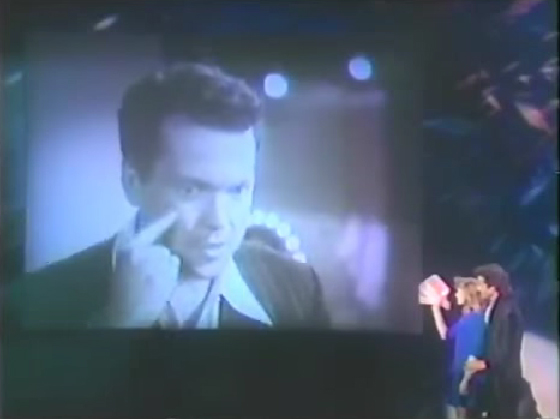
She throws them. Kind of like how the cards were thrown at Davey's face?

Orson catches one of the cards (now normal size) and shows it as being the Ace of Clubs. No, Dave says that it was instead the Jack of Spades. Orson then raises a very overlarge card and says, "You know it's remarkable, but on the screen some objects enlarge quite unusually." He turns the card over to show the Jack of Spades.
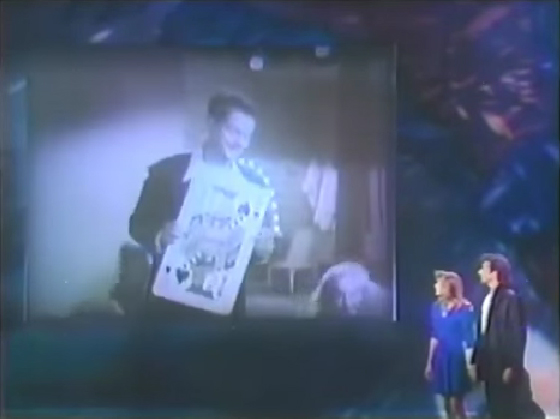
The Jack of Spades is revesed on the screen. I read this is because Copperfield had it reversed so he could interact with it using his good side. Which means instead of having the cards thrown at his right eye they were originally thrown at his left. Just as "Dave" was dubbed in every time Orson had said "Dick" (for Richard), then "right" would have been dubbed in for "left".
Though the Ace of spades and 4 of spades were the two cards that were several times shown the audience of Killer's Kiss, after the cards are thrown, when Davey is lying on the floor, subdued, the Jack of Spades rests beside his face. The Jack is a profile card, for which reason it is called One Eyed Jack, showing its right eye, and we have the same with Davey being shown here in profile, showing his left eye.

Just as Orson would have been showing his left eye with the proper, original orientation.

While the Jack of spades shows its right eye, the Jack of heart, another prilfe card, shows its left eye.
An expanded version of this is in the post THE INFLUENCE OF COCTEAU'S ORPHEUS ON KILLER'S KISS. . Please go to that post.
Davey's dream (shots 139, 140, 141 and 142) has the city streets in negative as a heckler's voice berates him as a flop, telling him to go home. He wakes from this to Gloria's scream, sees Vincent in her room, and races over to rescue her.

When Davey is on his way to rescue Gloria, the empty street of shot 335, in the Dumbo district, reminds very much of this dream. Davey's crashing through the window in shot 399 also takes us back to the dream. The lighting is such that we have the same sense of positive and negative reversal on Davey's body.

Some people make notice, as a goof, of how Davey is wearing dark socks before he plunges through the window, then when he lands on the street outside he is wearing white socks. I wouldn't be too sure it's a goof. It could very well be a reference back to the dream negative inversion, consolidating a relationship to the plunge through the window.
Shots such as these make me wonder if there is a nod to Jean Cocteau's Orpheus (1950).
The plot of Orpheus is based upon the myth, but there are considerable differences in Cocteau's film, such as that in the end Orpheus and Eurydice are returned to the land of the living.
In Cocteau's version, Orpheus is a poet, which will be given as the reason he is able to cross from the world of the living into that of death. At the film's beginning, he is present at a cafe when a younger rising poet is killed by Death's motorcyclists. This younger poet had caused Orpheus some consternation, he feeling challenged by this other poet's brilliance and popularity. Death, disguised as a princess, had arrived at the cafe with the younger poet and after he is hit by the motorcyclists she has him put in her car. Orpheus doesn't know yet that she is Death when she calls upon him to accompany her in her car, transporting the youth who Orpheus believes only to have been injured. She states she needs him as a witness. In the car, he realizes the youth is dead. After they are briefly stopped by a train, Death instructs her chauffeur to take the "usual route" to her mansion. It is at this point that the normal landscape viewed outside the window switches to a negative view.

In Killer's Kiss, we have Davey's negative effect dream/nightmare from which he awakens to hear Gloria screaming as she is assaulted. This dream/nightmare anticipates Davey's descent into the warehouse area later to search for Gloria, who has been kidnapped. The plot of Orpheus involves his rescuing his wife, Eurydice, from Death and the Underworld, and one can look at Davey's journey in Killer's Kiss as possessing some of the same elements, he having to rescue Gloria from Vincent.
In Cocteau's Orpheus, Orpheus' attention becomes focused entirely on messages from the underworld that come to him over the car radio, which he copies directly and gives as his own poetry. These are being sent by the poet who had been killed. Death has fallen in love with Orpheus, and he with her. Orpheus no longer paying attention to his wife, Death takes his wife to the underworld without permission, and then towards the end, out of love for Orpheus, she had reversed time and returned Orpheus and his wife to the land of the living with no memory of their travails.

The below shot is the final one from Orpheus, Death is led off with her chauffeur, Heurtebise, who has assisted her in transgressing the rules imposed on Death, he having fallen in love with Eurydice. Having been found guilty of breaking rules, they are to be punished. One does not know what will happen with Death and Heurtebise, only that it will be "unpleasant" and harsh.

That shot of Death and Heurtebise being led off to their punishment reminds me of the below.

Davey's manager is mistaken for Davey and is killed by a couple of Vincent's thugs in an alley. This is as they are leaving the scene of the murder, having disguised the death to look like a robbery.
Davey had told his manager to meet him at the dance hall at 49th and Broadway, but New Yorkers will recognize that the dance hall is at 46th and Broadway. Kubrick may have determined that the flip of the 6 to a 9 in 49th street was to be another demonstration of an inversion/reversal. But some of Kubrick's films have outright "errors", such as in Fear and Desire a portion of Shakespeare's The Tempest was paraphrased with an error.
In Orpheus, mirrors are beautifully used for moving between the world of the living and that of death. Sometimes the mirrors behave as water. In the scene in which Death steals away Eurydice, the mirror is instead broken.
First we see Death in her black dress. Here she is standing before the three-paneled mirror which is covered.

Cocteau cuts away from Death briefly. When the camera returns to her, Death's dress has changed so it is white. She faces the mirror and there is a brief flare of light that brightens her.

Death breaks the center mirror and the bright fill light is darkened. She steps through with Eurydice.

After they have passed through the mirror, it reforms.

Already, in Fear and Desire, when the General is shot, Kubrick employees a like effect of having a front fill light extinguished with the shooting.

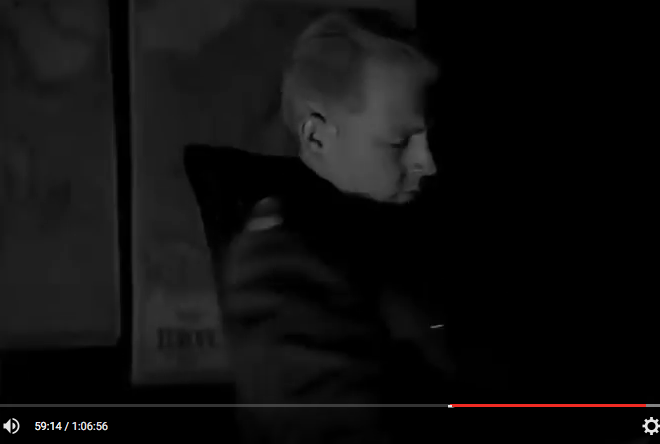
Kubrick employees the same effect when Albert, Davey's manager, arrives at 46th street (which should be 49th). He steps out of the taxi and Kubrick keeps the camera on the taxi as it pulls away, so that we see a man behind who is pulling something. The fill light that was on Albert stays ever so briefly on this person then goes dark. Our attention is thus briefly drawn up to the Himberama sign above.

Shot 277 a
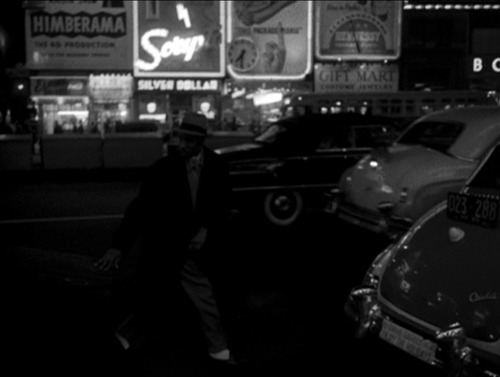
Shot 277 b
In Fear and Desire, the General had been shot at his table but isn't killed until he crawls out onto the porch, where he is confronted with his double in the Lieutenant, who kills him though he cries out that he surrenders. Albert, too, is a double of Davey in that he is confused with being him and killed in his stead.
In Killer's Kiss, before Davey leaps through the window he has on dark socks.

When he leaps through the window we are reminded of the negative effect had in his dream. One may also be reminded of Cocteau's use of mirrors in Orpheus.

Landing in the street, Davey's socks are now white.

It seems to me there may be a nod to Orpheus and Cocteau's use of positive/negative, that positive/negative observed also in the changing of the black dress to white as Death breaks the mirror in order to transport Eurydice to the other side.
Eyes Wide Shut has a noticeable black/white shift. The bedroom of Bill and Alice, when first observed before Victor's party, has a white phone beside the bed. The next night, when Alice and Bill fight and Lou Nathanson dies, the phone is black and the lamp has changed so it has a black base. The scene just previous involves Alice looking into the mirror of the medicine cabinet from which she removes the weed they smoke. Her earlier complaint in the film is that Bill doesn't even really see her anymore. In a sense she is lost to him with his no longer seeing her, just as Eurydice was lost to Orpheus.
If we look at Killer's Kiss as also being partly a retelling of the Orphic tale, as with Cocteau's Orpheus. we have Davey and Gloria happily reunited in the end following Cocteau's version of the tale.
Mirrors and windows are intimately connected in this film. Though there is no mirror opposite the window in the warehouse loft, with the breaking of the window we should refer back to shot 240 in which Vincent sees the close-up of the image of the two illustrated clowns in the window. There is no context other than the window, so we don't know these clowns are in a photo next to the window opposite the mirror that he breaks (see part three of the analysis for more on this). It seems relevant that we see the clowns in shot 240 and that Davey breaks out of a window in a loft on 24th street.
Now, let's return to the poster for the "Blue Jeans" melodrama we saw in Vincent's office earlier and which I briefly discuss in section one.
Nitrate Diva points to a surviving clip of the 1917 movie that she has put up at Youtube. As it turns out, the clip is pretty damn amazing and provides a little elucidation of that film's connection to Killer's Kiss.
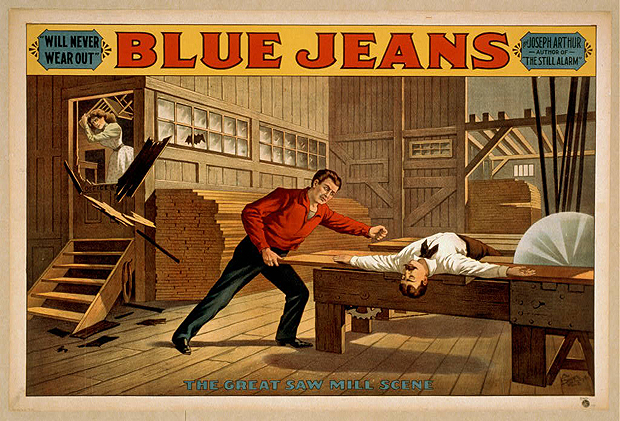
Wikipedia gives the plot of Blue Jeans as follows.
Perry Bascom returns home to Rising Sun, Indiana to make a run for Congress, and marry Sue Eudaly. Sue's ex, Ben Boone, is nonplussed at this turn of events, and successfully runs for office against Bascom. Bascom later sours on Sue, and divorces her to marry June. After various twists, Boone corners June and Bascom at Bascom's sawmill. After knocking Bascom out, Boone places him on a board approaching a huge buzz saw. June, locked in an office, escapes just in time to save Bascom from certain death.
The poster depicts June breaking out the door as she rushes to rescue her husband, Bascom, from being sawn in half by Boone. That Bascom is threatened by the saw mill blade is apparent, but to see this in the poster is very different from watching the film footage.
The website Murania Press notes that the Blue Jeans sawmill stunt (which was performed night after night on stage) became so firmly ingrained in public memory that early serial writers and directors referred to any hazard-portraying chapter ending as “a Blue Jeans finish.” I don't know if that "Blue Jeans finish" coding still exists, but it's certain to be lost on the majority today.
Relevant to the film Blue Jeans are these two shots from Killer's Kiss.

We see Davey lying on the ground next to the one-eyed Jack as Gloria attempts to seduce Vincent into believing she wants to go away with him and that she cares nothing for Davey.

Vincent distracted, Davey takes the opportunity to leap out the window.
Now for Blue Jeans. June, in the film, locked in a separate room by the now escaping villain, breaks out a window with a board in order to rescue her husband who is unconscious, has been placed on a log by the villain, and is quickly sliding toward the saw mill's blade.
In the below screengrab, June is breaking the window.

We have opposing shots of her husband in relationship to the blade, from one side and the other, he laid out vertically in relationship to it in the film whereas in the poster he is laid out horizontally.


June rushes over and in the knick of time she pushes her husband away from the blade. The log upon which her husband was riding is split in half by the blade.




June has, we realized, saved her husband from being made into a One-Eyed Jack, as in the card Davey faces on the floor. We don't get this "link" from the Blue Jeans poster because the poster shows June's husband situated in a horizontal relationship to the blade, not a vertical. And in the poster we don't see June busting out the window, instead we see a shattered door.
I've already described how the movie Himberama relates to this scene, but how does it relate to Blue Jeans and this scene.
Via illusion, Himberama blurred reality and the stage when an already long-since filmed Orson Welles, from the movie screen, dialogues with the stage magician and an audience member in the present and is able to somehow predict the card the audience member would choose would be a one-eyed Jack. And all wonder how it was done.
That saw mill scene in both the theater and film blurred reality with fiction in having the audience at the edge of their seats worrying about the real actor who appears to be in as dangerous a position as the fictional character. In the theater, the audience, not privy to the illusion, never knew if the actor might be injured. Even if they knew what was happening was a trick, how was it done? Might it go wrong? Those going to see the film are well aware the actor survives and are still on the edge of their seats, wondering at the mortal danger to which the actor might have been subjected. Alex in A Clockwork Orange was thrilled by the blood on screen seeming always more real than in real life. In Burgess' book, the films Alex watched during his Ludivico treatment were given as being so realistic, without observable cuts, that he couldn't figure out how what he was watching might not be real. We have much the same confusion with the danger presented the actor by the saw, and thusly for the audience a blur between observation and participation through the danger to the actor.
The threat of the saw mill cutting through the actor anticipates the warehouse with all its mannequins, and especially those with the bisected torsos.
I've seen it stated that a known inspiration for the mannequin scene in Killer's Kiss is the mannequin scene in Fred Astaire's 1953 film The Band Wagon. In The Band Wagon, Astaire is led by a mysterious woman into a room filled with mannequins and parts. The woman herself is in some ways related to these mannequins as Astaire described how she came at him "in sections". In the mannequin room, two heads turn out to be real thugs who chase Astaire.
That dance sequence was "The Girl Hunt Ballet" and there are at least a couple of other seeming homages to it in the film. The fire escapes Davey climbs remind of the one Astaire climbs.
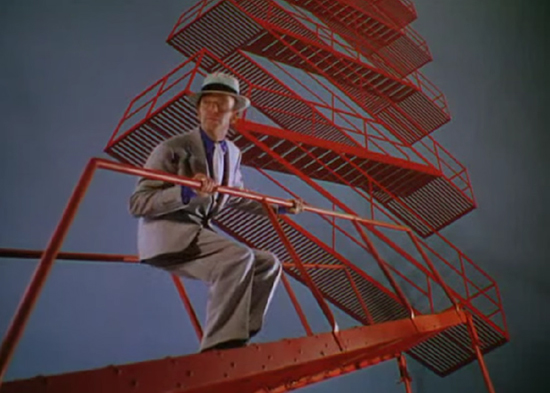
Also, stuck in the counter in the mannequin room in "The Girl Hunt Ballet" is a big butcher knife.

This reminds of the extra large butcher knife hanging on the wall in Davey's apartment.
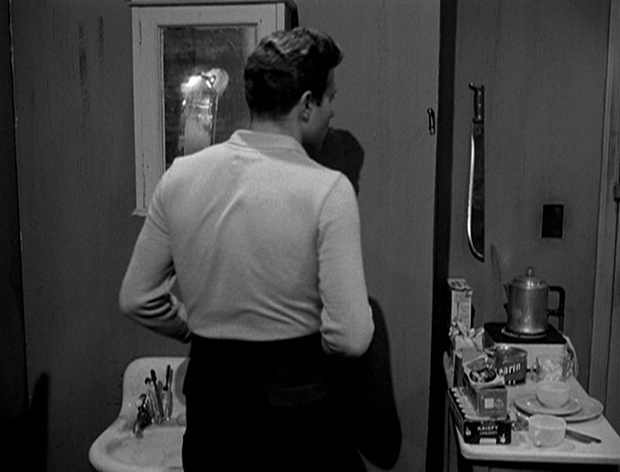
Kubrick used ideas relating to mannequins throughout his career. He zeroed in on this with the Lolita quote of people being treated like furniture, then in A Clockwork Orange we have mannequins serving as furniture, and, eventually, in Eyes Wide Shut we had people serving as furniture at the "orgy" with its mysterious, mannequin-like partiers. So though The Band Wagon might have supplied some inspiration for the fight scene, we have a deep and abiding interest with Kubrick in ideas surrounding humans as mannequins.
Kubrick's wife at the time of Killer's Kiss, was Ruth Sobotka, who played the ballet dancer, Iris. In 1947 she had been in the surrealist film, Dreams that Money can Buy, specifically the Man Ray portion, "Ruth, Roses and Revolvers", in which theater-goers are encouraged to replicate what is happening on the movie screen. But the short preceding this was Fernand Leger's, "The Girl with the Prefabricated Heart", was all mannequins, with lyrics concerning today's goddess being formed on the assembly line. Her heart, as well, is sterile, prefabricated. The gods send her a mail-order, perfect mannequin man, each made for each other. He loves her truly and they become engaged. Married, the prospect of physical love for the mannequin frightens her, it making a muss of her perfect hair and clothes. Fearing emotions, she flees. Thus she remains pure, while the groom, abandoned, crying, disintegrates.
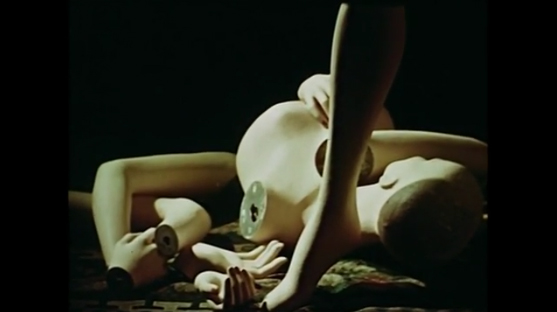

In The Prefabricated Heart, the mannequin assembling itself out of parts certainly reminds of the warehouse mannequin scene and all the mannequins in various stages of assembly, some whole, some in parts.
Stepping back to "The Girl Hunt Ballet" in The Band Wagon--why might Kubrick have a specific homage to this?
The ballet's story is a spoof on detective novels. A blond seeks the help of a detective and is described as a girl you just want to protect, which is her manner of being a seductress. A man appears, picks up a bottle and explodes, nothing left but a bone, a rag and a hank of hair. These are clues meant to tell the detective something, left by this man. The detective finds at a fashion house the textile. While there he comes across an emerald, and a dark-haired vamp (who is the blond as the siren). In the back area of the fashion house, where are the mannequins, there is a butcher knife. He fights some men who were hidden among the mannequins. At the 42nd street subway station, he meets the blond again and dances with her while men fight behind them. The bone leads him to a nightclub decorated with a skeleton where he again finds the dark-haired vamp and dances with her. Suddenly he realizes who the killer is who is at large in the city. And killers must be killed. He shoots the killer-- the blond. She falls into his arms and extracts one last kiss from him. Then he goes out into the night and meets again the dark-haired version of the blond and goes off with her.
Is this from where the name Killer's Kiss partly derives? But then what has the blond to do with Gloria?
The clues are a puzzle unless we know that the rag, the bone, and a hank of hair poem refer to "The Vampire", a Rudyard Kipling poem that was intended to help promote the painting, "The Vampire", by his cousin Sir Philip Burne-Jones.
The Vampire
A fool there was and he made his prayer
(Even as you or I!)
To a rag and a bone and a hank of hair,
(We called her the woman who did not care),
But the fool he called her his lady fair--
(Even as you or I!)
Oh, the years we waste and the tears we waste,
And the work of our head and hand
Belong to the woman who did not know
(And now we know that she never could know)
And did not understand!
A fool there was and his goods he spent,
(Even as you or I!)
Honour and faith and a sure intent
(And it wasn't the least what the lady meant),
But a fool must follow his natural bent
(Even as you or I!)
Oh, the toil we lost and the spoil we lost
And the excellent things we planned
Belong to the woman who didn't know why
(And now we know that she never knew why)
And did not understand!
The fool was stripped to his foolish hide,
(Even as you or I!)
Which she might have seen when she threw him aside--
(But it isn't on record the lady tried)
So some of him lived but the most of him died--
(Even as you or I!)
And it isn't the shame and it isn't the blame
That stings like a white-hot brand--
It's coming to know that she never knew why
(Seeing, at last, she could never know why)
And never could understand!
Kipling's poem sounds like it has to do with a man's sore ego.
What this poem says in relationship to The Bandwagon is difficult enough to parse, for The Bandwagon is not a sexist film. Women are a significant part of the show being put together, are involved in the creative process, and as performers. At the beginning of the show's production, there is a tug of war between the male lead (Astaire) and female (Cyd) but its origin is not in any "battle of the sexes". Instead the problem is each their own insecurities in working with another individual they very much respect and to whom in some fashion they feel inferior. These misunderstandings ironed out, their battle then is with the material. A failing show is reshaped and along the way the couple inevitably fall in love with one another. Cyd is no vamp. She's a hard-working dancer. "The Girl Hunt Ballet" doesn't appear to be a Shakespearean mousetrap other than its end anticipates Cyd and Astaire getting together as it has the detective feeling a vacancy after the shooting of the killer blond, and her dark-haired doppelganger stepping in as his abiding love interest. Indeed what seems to be played out is the switch from the initial, fledgling romantic interest (the blond) to a permanent one (the brunette). The woman to whom he is attracted leads him to the one with whom he'll fall in love. They are one in the same but representing different stages of the relationship.
Is the poem instead intended to be interpreted in respect of perhaps the harsh arts or audience taking all from a creator and giving little in return?
Kubrick, in The Shining, will also quote from Kipling but in a manner that highlights Jack's misogyny, his rancor toward Wendy.
My read is not that we are to view Gloria as a kind of helpless blond vamp who has taken advantage of Davey, guessing he would step forward as her protector, falling in love with her as she becomes his cause, and will free her from her situation. Indeed, she tells him she doesn't want his pity. But that may be there, never-the-less, or we could view Davey's relationship with Gloria advancing from one stage to another after the killing of Vincent and her showing up to meet him at Penn Station, which he was indeed worried might not happen. Gloria was, after all, a taxi dancer, and they were known for "propping" men, setting up a date (for sex) with them, taking money for it in advance, and then failing to show.
Minotaur was Kubrick's name for the company who produced the film, and Kubrick evidenced interest in the labyrinthan throughout his career. Perhaps the why of this, as well as some other myths he used time and again, is because they are so deeply rooted in our western psyches and culture that Kubrick was possibly exploring some inherent truth in the symbolism, for which reason the longevity of these myths. They were expressive of something in nature that might emerge in various aspects of our lives however unnoticed when dissociated from the classically representative symbology. Referencing such myths also means a readymade back story of sorts and a springboard for various associations to be roused in the viewer, consciously or even unconsciously. The Orpheus myth is a good example as everyone has something that dies, that they try to restore or keep, and are unable to do so.
My proposition is that from the beginning the labyrinthian has played an important part in the structure of this film, beginning with the mirrored apartments of Gloria and Davey duplicating the double-headed axe, the labyrs, a fundamental organization we have repeated in Kubrick's films.
Most people will want examples of explicit representation as proof, and even then many will question this manner of a deep symbolic approach (and structure) to cinema as they think only in terms of entertainment rather than art, though they would have no argument with seeking such symbolism in the literary works of writers such as Joyce.
Kubrick only rarely gives explicit representation, providing hints instead. But we do have the explicit in Killer's Kiss.
First, I'd like to give a couple of academic passages on the connection of the labrys and the fleur-de-lys, for though I can look at the two and see how they emerge from the same source, others will want quotes. I give broad swathes for a reason but you can piecemeal and just pick out the parts on the labrys and the fleur-de-lis and do just fine.
Minos was above all the priest-king. A religious impression is produced by the whole wing of the palace-sanctuary, where he presents himself to the general gaze seated on his throne guarded by gryphons. He is the representative of the Bull God, the incarnation of the Minotaur, whose image appeared everywhere on the walls, and dominated the gateway of the sacred dwelling. When the divine bull had received the name of Zeus or, as the legend has it, when Zeus had taken the form of the divine bull, Minos was the son, and, according to the Odyssey, the "companion of great Zeus". Once set apart by the divine will for the veneration of men, he became "king for a period of nine years". At the end of that time the divine power which had been breathed into him was exhausted and had to be renewed. He climbed the sacred mountain to converse, to commune with the god. He entered the awful grotto of the Minotaur, he penetrated the most mysterious of all labyrinths, he came to render account to his father, to bow to the judgment of his master. In that hour the island was in anguish. All those whose fate depended upon the forthcoming decision made sacrifice, in breathless suspense, of chosen victims. It was perhaps for these festivals that the tribute of seven young men and seven maidens, exacted every nine years, was reserved. If the god was dissatisfied with his chosen, he kept him, and the king who was condemned was never spoken of again. If the god was satisfied, Minos, renewed for nine years, came down again into the midst of his people with a fresh store of power. Translated into modern language, the legend seems to mean that the priest-king held his power for religious investiture, and that he was appointed for nine years and re-eligible.
The king, like the god, had as insignia the sceptre and the double axe, the labyrs. Two thousand years before it became the symbol of authority in Rome, the axe already held that position in the palace of the labyrinth. The kings of Knossos had perhaps another emblem besides, the fleur-de-lys. Strange coincidence. Are we to believe that the three-pointed flower symbolized a religious idea, that of the trinity? Nothing either confirms or belies this hypothesis. The fact remains that in L.M.II the fleur-de-lys appeared in all parts of the palace of Knossos, and spread over the whole Aegean world. The figure on the painted relief, with the crown of fleur-de-lys topped with great plumes and the necklace of fleur-de-lys, is Minos himself. The royal flower appears in devices, on seals, it is painted on walls and on vases.
Source: The Aegean Civilization by G. Glotz
The Minos was a god-king, and the Labyrinth of Knossos was the sacred habitat of the god. The divinity was incarnate both as an animal (the sacred bull) and as a man (the Minos). The bull-god received human sacrifice, of which the memory survived in the myth of Theseus and the abolition of the Athenian tribute...One phase of the ritual drama was the immolation of the bull-god himself; and those who wished to commune with the gods participated in the sacred meal. The offering was preceded by a corrida in honor of the gods, and on this occasion probably slaves and prisoners of war were used as bullfighters and human sacrifices. Some understanding of the meaning of these rituals, in which elements of a totemistic age survived, can be gained from Plato's Critias where, based on oral tradition from the Aegean past, the bullfight and the sacrifices form the core of the Atlantian rituals of order.
The bull-god was neither the only nor the highest divinity. The matriarchal Minoan civilization was dominated by a goddess whose functions resemble those of the corresponding figures in the Near Eastern pantheons. She appeared as Dictynna, the Great Mother (the Rhea or Demeter of the later Greeks), and as Britomartis, the virgin daughter who was united with the god in sacred marriage (Kore, Persephone, Artemis, Europa, Pasiphae in the later myth). To the fusion of mother and daughter corresponded the fusion of the god as son and lover. There was a wealth of myths--of Minos and Britomartis, of Dionysos and Ariadne, of Europe and Zeus in the shape of the bull, of Pasiphae and the bull-god in which are blended the figures of the Great Mother, of the son and lover, the totemistic and anthropomorphic symbols, the fertility of earth and the animal world, and the earthly and heavenly powers. What always remains discernible through this veil of not exactly dateable stories of gods, men and animals is, first, the Labyrinth, the royal palace, and second, the Minotaur, the offspring of Pasiphae and the Bull, the incarnation of the divinity that required human sacrifice...
In the sacrifice of the sacred bull the double axe (labrys) was used, from which the habitat of the god, the Labyrinth, received its name. The labyrs, originally a stone that was supposed to be the male god, belonged to a fetishistic stratum of symbols even older than the totemistic. This stone axe is found at an early phase in the Asiatic cultures, and since it appears in Crete earlier than with the peoples who settled between Mesopotamian and the Aegean, original connections between Minoan and Mesopotamian cultures are probable. Parallels suggesting such connections, however, occur only on the level of fetishistic and totemistic symbolisms, of animal incarnations of gods, and of the Osiris and Tammuz symbolism of the dying and reborn god...
Peculiar to Crete is the development of certain symbols that imply a cult of sacred numbers. One of them, the fleur-de-lis, is of particular interest, because it apparently was an original creation of Minoan civilization. Together with the labrys, this symbol of the trinity has been carried to the farthest reaches of Minoan influence. It is so omnipresent that the Minoan sphere of power has, on occasion, been called the realm of the fleur-de-lis.
An interpretation of the fleur-de-lis must beware of suggestive associations. It is not advisable to speak of the symbol, as has been done, as if were a mysterious achievement of manking in the dim past...What trains of speculation the Cretans associatied with the fleur-de-lis we do not know, but its very existence proves that, at least in sacerdotal circles, the elaboration of problems of origin and power must have gone rather far...
An approximate idea of the intellectual processes involved in the creation of the symbol can be formed through a comparison with the closely related Pythagorean tetractys. The tectractys consists of the first four integers, adding up to ten, represented by pebbles or dots so that they will form a triangle. The tetractys was invoked in the Pythagorean oath as containing "the root and fountain of overflowing nature." As far as the meaning of the symbol in detail is concerned, Aristotle has preserved an interpretation of the first three numbers: the even is the Unlimited, the odd the Limited, while the One is even and odd at the same time and, therefore, the origin of the Limited and Unlimited. According to other sources the even was identified as the female principle, an element of unorganized chaos, needing the union with the male principle in order to determine itself to a definite product, while the odd represented the male principle. The monad, in this construction, was the bisexual origin, capable or releasing the even and the odd from its undifferentiated unity. A trinitarian symbol, thus, may express more than one train of speculation. It can symbolize the sex differentiation, representative of Becoming, and the originating unity, representative of Being, but it can also symbolize the two procreating principles and their offspring. Whatever the Minoan meaning may have been, the existence of the symbol indicates that speculations on "the root and fountain of everflowing nature" must have reached a high degree of abstraction.
...On a gold ring from Mycenae, representing an offering to the Great Mother, the goddess sits under the Tree of Life and among the symbols surrounding her there can be discerned sun, moon, and several stars (perhaps the galaxy) in addition to the labrys and the fleur-de-lis. The aggregate is something like a Minoan pantheon.
Source: Order and History, Volume 2, Eric Voegelin
I cover a little, in the analysis on Eyes Wide Shut, how the labyrinth was not only a prison hiding the Minotaur, it was also a dancing ground for his sister, Ariadne, who supplied Theseus the string (the clue) by which he found his way out after killing her half-brother with the labrys. As Homer relates, "Daedalus in Knossos once contrived, A dancing-floor for fair haired Ariadne". That dancer may appear in the form of Iris' ballet (which she is forced to abandon) and Gloria's taxi-dancing at the "depraved" Pleasure Land.
The red ball of Ariadne's thread is said to have been also made by Daedalus and reminds of the story of Daedalus threading the snail shell, also a version of the labyrinth. We see a snail shell in the goldfish tank in Davey's room.
The below image shows, on the left, the labrys axe, and on the right the fleur-de-lys. The fleur-de-lys is an iris. We are, then, not finished with Iris after Gloria's story of her. She returns in the mannequin factory, along with images of string. In shot 451 Vincent seizes the axe from the wall. The fleur-de-lys, the iris, is supplied with Davey taking the pike pole as his weapon. As we can also see in the below image, when the pike pole is doubled we have a fleur-de-lys. We need to envision the axe and the pike pole as being doubled in this fashion, a clue given by the double/mirrored keys that Davey leaves on the table when he vacates his apartment.

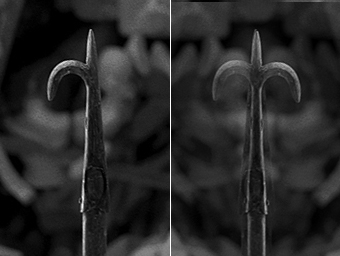
I have previously discussed how Vincent bears some resemblance to the father of Gloria and Iris. The choice of name is interesting, however, due Vincent Cartier having been the boxing twin of Walter Cartier in Fear and Desire. In the mannequin factory we have not only Vincent but also Walter, for in shot 435, Vincent having lost his gun, we see it next to a box which has written on its side something about "motion picture" and the name "Walter" as well. The name "Jacobs" is also on the box, and the first thing my mind goes to is the twinship story of Esau and Jacob. Regardless if E. H. Jacobs has any meaning, here is Walter.
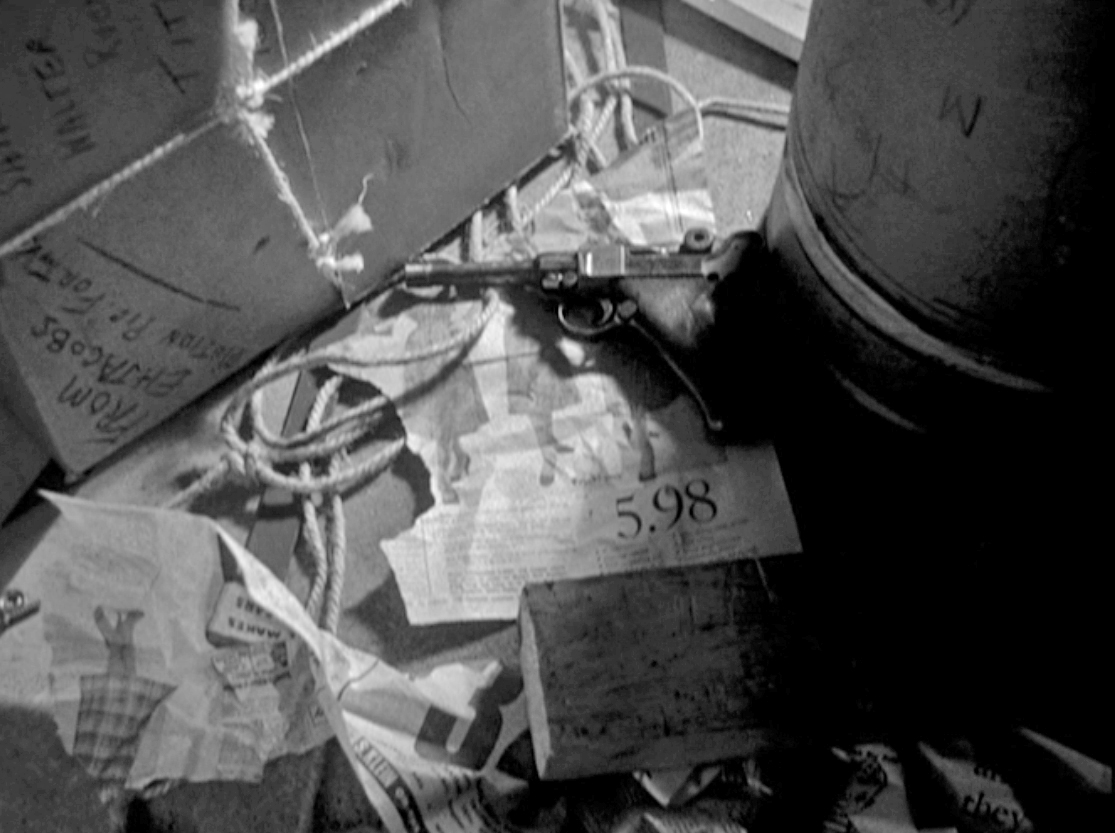
Vincent's grabbing the axe from the wall in shot 451 takes me back to the peculiar cut of Gloria from shot 225, when she is moving toward screen right, so that she disappears while she is still on screen, one shot becoming two, 225 and 226. Add together 225 and 226 and one has 451. Absurd as this may seem, I look at Vincent's grabbing the axe, in shot 451, as relating to shot 225 becoming 225 and 226 through that shot having been sliced in two, while also having to do with the mirroring symbolized by the the labrys. It's just a feeling I have from my analysis of his other films, and other elided shots similar to this involving a mirroring or change of direction. I have considered it was simply clumsily done in The Killing and Killer's Kiss and was later refined. These elided shots in The Killing and Killer's Kiss may have been an evolution from the fairly clumsy use of flipped shots of the murdered soldiers and girl in Fear and Desire.
Past a certain point, there is no rational deciphering of the function of symbols, their sensibility comprehended instead in the indefineable mystical, in poetry. The fierce Iris returns in the aspect of the fleur-de-lys and is the instrument by which Vincent is killed, the scream from him had at the same time we view a quiescent, female mannequin's face (Iris' face had been described like a stone, she not even blinking when she'd heard their father had died), and the scream then transforms into a train whistle. Vengeance is had. One senses in Gloria's taking the job at the dance hall, with no idea why, the full weight of the automaton somnolence that has guided her, and how, via Iris, she has been finally freed and will be able to pursue her own life. Iris has, through Vincent's death, also exacted revenge on their father, who looked very much like Vincent.
In shots 488 and 489, Davey waiting for Gloria at Penn Station, the voice-over for announcing the trains begins, stating, "The Pathfinder to Chicago and Seattle leaving at 2 o'clock, West Gate, Track 13. Passengers for Pittsburgh, Chicago, St. Louis and Seattle, this train has reserved...dining cars, and sleeping cars designated as 494, 493, 492. 491 and 490."
There are exactly 494 shots in the film. So what Kubrick is doing is listing off those last 5 shots in the voice-over, essentially telling us we're supposed to end on 494.
There would be, however, 493 shots if I had not split shot 225 into shots 225 and 226. Why did I split shot 225 into shots 225 and 226? Gloria disappears from the frame during shot 225 (I supply video of this in section 2 of this analysis), and it's likely many would count that as one shot, despite the fact she disappears from the frame. But it needs to be counted as two shots. When Gloria "disappears" in the shot, she has just finished describing her sister's suicide by slashing her wrists. 225 and 226 add up to 451 and in shot 451 Vincent grabs the axe from the wall. The axe in shot 451 works also as a signal that the shot needs to be counted as two. I know this sounds bizarre but it's the way it is.
As with Fear and Desire, the ads for Killer's Kiss promised something other than was delivered. HER SOFT MOUTH WAS THE ROAD TO SIN-SMEARED VIOLENCE! promises one thing, and instead the viewer gets a woman who has been raped then kidnapped and her new boyfriend trying to rescue her.
For some reason one of the ads for the film featured another couple rather than Vincent and Gloria or Davey and Gloria.

They are a couple from the film whom we see first in shot 61 dancing at the Pleasure Land. We then see them dancing again in shots 76 through 80, when Vincent goes down to get Gloria to watch the boxing match with him. The most prominent shot of them in that section is shot 78 when we get a clear view of them standing next to Gloria as Vincent bullies the soldier with whom she was dancing. But the shot upon which the poster is based is 256, when Gloria has returned to the Pleasure Land to get her paycheck and is walking through the dancers the following evening. The dancers are the same as the first night and she is passing behind the couple.
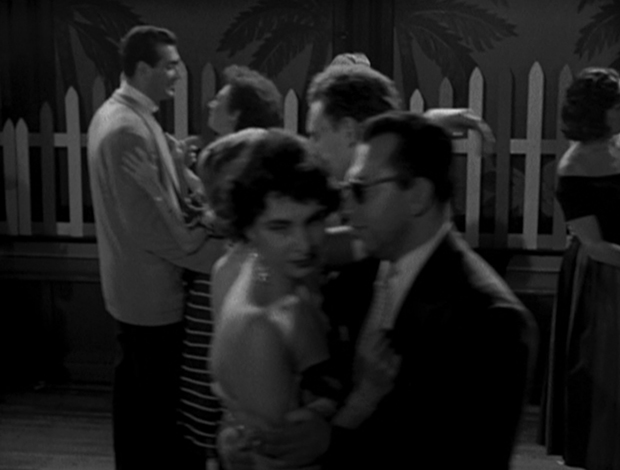
In the below shot, from the first night, we have a better view of the woman's dress, which is the same as in the poster.

Is the brunette Barbara Brand, the only other taxi-dancer named as an actress on IMDB?The way the couple is posed their manner is unlike that of Davey and Gloria, the man in the identity-concealing sunglasses feeling more predatory.
Why use a different couple than Davey and Gloria? I have wondered if it was simply Kubrick's way, again, of exploring doubles, this time in the poster advertising the film. And I think the mystery as to the why could very well have to do with the homage to "The Girl Hunt Ballet" from Astaire's The Band Wagon, which I've discussed above as having influenced this film. As I'd noted, Cyd plays both a blond and a brunette. But there's more to this story...
THE GIRL HUNT BALLET from James Munn on Vimeo.
I've already written of the obvious references to the film above. But let's explore the film a little further.
A mystery unfolds after the blond seeks the help of Astaire, and he is eventually led to the brunette vamp who first emerges from behind mirrors reflecting her when he sees the same large emerald ring that he had found after the blond ran off when the man exploded, a ring which was then stolen from him. He takes the clues left behind and by means of them tries to sort out the mystery, the emerald appearing from place to place and linking these two women together. The woman is also elusive physically for when he touches her arm on the mannequin set she separates from it and he sees it's not her real arm at all. The emerald escapes the bounds of the ring and becomes a clue of color that he also follows from place to place. He sees the facade of a wig shop decorated with some emerald fabric, and receives from this the nonsensical "hunch" to ascend a fire escape where he finds in an elegant bathroom at the top, a room decorated with green, a woman in a gold mask bathing with the ring on her finger. Every time he comes upon the ring and the woman he's assailed by several gangsters and has to start searching again. Finally, he comes upon the jazz club decorated with a skeleton. It is here he has his realization about the trumpet. In the ballet, the blond is shot, because she is "the killer". They kiss one last time, as she supposedly dies, the emerald ring now on her finger and slipping off into his hand. Then Astaire goes off with the brunette. Cyd's character, the dancer who plays both the blond and brunette, is Gabrielle Gerard. Throughout this dance there have been men periodically exploding and leaving nothing behind. The first time, he had picked up a bottle. At a jazz bar, Astaire hears a person, whose face is concealed, playing a trumpet, and he realizes nitroglycerine is a glass that was served him and that when the trumpet player hits a high note the glass will explode, that it was the high note on the trumpet that had made the other men explode.
If we reflect on the name and the trumpet we realize that what we have is Gabriel's horn, Gabriel being the angel who was said to play the horn announcing Judgment Day and the resurrection of the dead. Kubrick returns to Judgment Day in the opening of The Shining with "Dies Irae", which I discuss at length in that analysis. Then he returns to it again in Eyes Wide Shut in the coffee shop where Bill reads the newspaper that on the front reads "Lucky to be Alive", and on the interior reveals Amanda has overdosed.
The nitroglycerin is actually a gloss, because it's the emerald that is important and explosive. "Emerald" has a long etymological history that takes us from the esmeraldus of Medieval Latin, to the smaragdus of Latin to the semitic baraq (shine), and is to be compared with barq, the Arabic word for "lightning", and bareqeth, the Hebrew word for emerald. The Buraq (from barq) was a mystical horse, sometimes said to have a human face, smaller than a mule and bigger than a donkey, that was related to have been brought, by the Archangel Gabriel, to Muhammad. He tethered it to the Buraq Wall (the Muslim side of the Wailing Wall on the Temple Mount) and rode it on the Night of Ascension. The horse travels with lightning speed, so one on it could be thought to suddenly disappear. A whirlwind was also descriptive of that state of journey. Another means of ascension is the heavenly ladder or staircase. A correspondance is drawn in the ballet film when after his hunch at the wig shop Astaire climbs the bright red fire escape into the sky
If we go back to the letter Davey reads on the train, we are reminded that his aunt, Faith, is able to ride again, and that they have purchased an Arabian stallion. The first image that Kubrick shows us after the train is a mechanized Santa Claus. How does Santa Claus get around? On a sleigh drawn by horses that can have him magically visit all the children in the world in one night. That sounds a lot like the magical powers of the buraq.
My guess is that Kubrick recognized in the emerald of the film the real connection being made with the explosive and sudden disappearance of the men that left nothing behind. From there he may have made other connections, such as with the Merkabah, Ezekiel's wheel, a chariot driven by heavenly beings that had, as did the buraq, composite forms that also bore a human feature. It was also associated with the seraphim, "burning" angels. Like the buraq, it was a mystical representation of a state-of-being of transcending the heavens, a state of attaining arcane knowledge. With Kubrick, I consider, with his interest in doublings, what associations he might have made with the story of Elijah and Elisha. Before Elijah ascended in his chariot of fire (also a windstorm), his disciple, Elisha, requested that he be allowed a double portion of his spirit. Elijah said he would receive this if he was able to keep his eyes upon him as he ascended. Elisha was able to do so then afterward tore his own clothes in two and took up the mantle of Elijah. A peculiar story about Elisha has him being taunted by forty-two boys for his baldness, and his retaliating by magically having two female bears kill them. Though, in the ballet film, the rag, the bone, and the hank of hair refer to the poem by Kipling, "The Vampire", the discovery of the wig shop occurs after the detective following the woman to the 42nd street Times Square station where, one after another, pairs of gangsters cross the stage shooting each other. 42 and the wigs might remind of the story of Elisha. It's been suggested the "baldness" is a dual state, Elisha now wearing the "hairy" mantle of Elijah, and that his authority is being questioned, is he really imbued with the double spirit or is "bald" as in not having spiritual authority. The young men call on him to "go up", as if demanding he prove himself by ascending as had Elijah. As for the baldness, the word is qereab which we can see is as perhaps a reversal of barq, that emerald.
What exactly all this means differs from teacher to teacher, you can't take a photo of it, there is no ABC methodology. There's no point in getting into any kind of practical interpretation. All that I'm making a case for here is that we find elements of this mysticism when you put Gabriel and Gabriel's trumpet together with an emerald in a surreal story of a detective trying to figure out the mystery of the double-dame and men disappearing when she's around. As for Astaire, Tony Hunter, though he gets the emerald from the blond, when he later goes to light a cigarette and pats himself down for a lighter he finds "something is missing", which is the emerald given a correspondence with the lighter, which is when the brunette returns. He gets her instead because, of course, she is everything to do with the emerald in the first place.
August 2014 transferred to html. Approx 12,800 words or 26 single-spaced pages. A 98 minute read at 130 wpm.
Go to Table of Contents of the analysis (with supplemental posts)
Link to the main TOC page for all the analyses